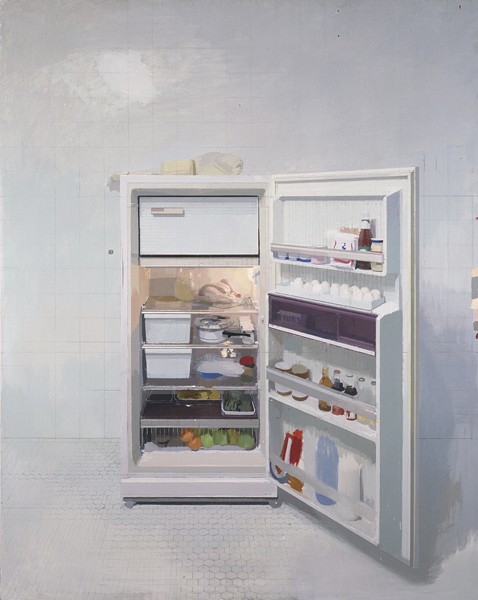 |
| Untitled (Red Dresses) 2010 Stephan P. Ferreira |
 |
| Detail from Untitled (Red Dresses) 2010 Stephan P. Ferreira |
I've labored so much over how I've articulated the imagery that trying to decipher any meaning is the same experience as trying to figure out what a word means after it has been repeated over and over: the word looses it's context, it looks foreign and suddenly you can't even remember if those letters are arranged correctly.
Having been so wrapped up in the painting I can only see the trees in the forest, as it were. It takes stepping away to eventually see the bigger picture. But before then, it's usually these small areas in my paintings that teach me and prompt me to do something else.
A recently completed painting based on a Depression era photograph got me thinking about what changes need to be made in my own process and what the successes in my work tell me about my focus and patience.
Red Dresses was painted as a gift in just a couple of days. It became less about the subject matter (like most of my work) and more about figuring out my process.
Since seeing Antonio Lopez Garcia's work a few years back, I have been consciously trying to figure out how to maintain emotional, abstract marks while articulating something very exact. Garcia's work manages to accomplish this, like in New Refrigerator, shapes for color are drawn on the canvas, and the color marks themselves seem to take precedence over the object they define (it should be noted that some of his paintings take a few years).
This investigation sounds obvious - but I habitually work off-the-cuff, which means often I muddy things up. Using a very primary palette, I mix only a few local colors. Then I paint and repaint forms quickly, scraping down and rebuilding. Another words I usually figure out forms or space directly on the painting - my entire understanding or misunderstanding of it exists there.
 |
| New Refrigerator 1991-94 Antonio Lopez Garcia (via Berkshire Fine Arts) |
| Detail of Daughters of Edward D. Boit John Singer Sargent (via Daily Blague) |
The book has always been one of my favorite monographs because the layout shows her paintings and then via various super-close ups and studio shots shows all the other material and investigating that goes into a single painting.
What successfully articulated spots there were in Red Dresses were a result of early gridding and laying out decisions. One example is the woman holding the child in a blue dress downwards to the young girl facing the same direction. I gridded the image and then laid out simple dark and lights. The spare marks remaining reveal an underpainting for something else entirely. I'm reminded of the young girls doll painted with just a handful of decisive strokes in John Singer Sargent's Daughters of Edward D. Boit.

Another example is of the space between the girl's arm who wears a pink dress. The scratchy and thick colors were decisive but simple enough to articulate the change in light.
But while there are lots of quick successes in Red Dresses, what those really convinced me of was that I should be working with more studies, more time and more focus.
The highlighted details of the painting show me that I'm sometimes unable to see the forest through the trees and that when I am able to steady myself and be decisive about my choices, my quick habits could articulate even more.



No comments:
Post a Comment